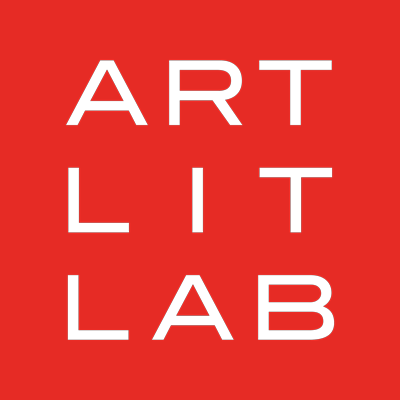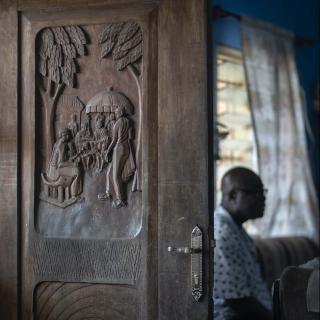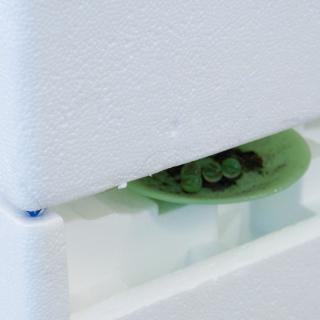This particular spring, emerging from the challenges of 2020 seems like a perfect metaphor to celebrate three young artists whose work was featured at the Arts + Literature Laboratory Gallery from March 11 to May 1. Two of the artists—Rita Mawuena Benissan and Conley Clark—were recipients of the ALL Prize for outstanding graduating MFA students from the UW-Madison. Craig (Jun) Li is an artist from China, currently based in Madison, and an undergraduate at the university.
“My family always tells me ‘where ever you are living, Ghana will always be home,’” says Benissan. In her multi-media exhibition, Mo Apiafo, she combined archival pigment prints and three reinterpretations of the Ghanaian royal umbrella to create an often joyful, sometimes circumspect, and always welcoming feeling of home and ancestry.
Her prints, titled “Homegoing,” lead off with an intriguing, divided image that invokes what a child might experience when venturing into a room where the adults are conversing. On the left, in the foreground is an ornate wooden door carved with images of a Sika Dwa, or golden stool, and a royal umbrella, motifs replicated throughout the installation. On the right, in a slightly blurred background, is a man seated in profile whose attention is elsewhere. Similar to the obscured man in this first photo is a woman in a vibrant blue printed dress walking away, going about her own business, and another woman who reveals to us the nape of her neck and her earring, but not her face. Interspersed with these preoccupied individuals is a no-nonsense fisherman, a seated woman who looks us over with playful incredulity, and two children conveying poise, trust, and innocence. Benissan’s photos have the rare gift of imbuing their subjects with life. We feel their presence and acknowledgement.
As we interact with these prints, we wander around three large umbrellas—one upright, one upside down, and another on its side. These various positions afford us generous views of the canopies’ gold and crimson images set on rich black velour. On the umbrella lettered with the Twi words for, “I was a queen for a day,” is the profile of a Queenmother. Two large profiles of a young Chieftain appear on “I was a king for a day,” and a hand gesture, which in Ghana is often used along with the affirmation “Mo apiafo,” appears on the third umbrella. This translates to “Power onto you” and also “well done!” These symbols are repeated as golden finials on each umbrella. Benissan’s designs for these pieces were constructed by Ghanaian umbrella makers, a collaboration that furthered her self-identity through her heritage, as well as her artistic and aesthetic goals.
From this hygge-like ambiance of an outdoor market, we transition to the illusory expansiveness of Conley Clark’s (Sub)urbia. The chatter we might imagine from Mo Apiafo gives way initially to a silence reminiscent of the 2020 quarantines. “I used this time to forge a new home,” says Clark, who unexpectedly purchased a house in a Madison suburb with his partner, just prior to the pandemic. The routines of mowing the yard, watering plants, decorating rooms, and cleaning up messes led to contemplations about privilege and his own history of being raised in an appearance-conscious family in the Bible Belt. Eventually, these mundane tasks were transformed as Clark pondered how he could see himself “…as an accessory to queer politics in an overwhelmingly traditional setting.”
The installation is comprised of several delightfully surreal set-pieces. In the center, an AstroTurf walkway ascends three steps to an invisible structure. As we corral ourselves around two solar-powered walkway lights, we sense we must keep off this grass, especially since chained to the edge of this lawn, like a forlorn pet, is mannequin-foot swathed in a white ankle-sock. In “Touching”, a plaster finger emerges from the tip of a coiled garden hose and is tied with a bow. In the composition, “Please Won’t You Be My Neighbor?” a re-painted Hummel figurine innocently clutches a small scythe. Could this child, reminiscent of Patty McCormack in The Bad Seed, be unthinkably responsible for these severed body parts?
A motion-sensor triggers the video, “Sometimes a Wind Blows and You and I Float,” and dreamlike, synthesized music accompanies the imagery of windblown blades of grass and fluffy, rose-tinged clouds. A second video, “Practice Set,” plays on a monitor atop a media stand with sliding doors, opened slightly to emit a deep-pink glowing light. This video, shot with an iris effect invokes a feeling of surveillance and reveals the feet of someone struggling, but eventually succeeding, in putting on a pair of black, steel-toed stilettos.
A circular hand-towel ring affixed to an otherwise barren, white wall is among the many objects Clark repurposes with irony. In this instance, the object, placed at the entrance and exit of the installation suffices (for appearances’ sake) as a door knocker.
Artist Craig (Jun) Li also employs repurposed or discarded objects in their installation ESL. Here, items like Styrofoam packing, squares of sheetrock, SX-70 Polaroid photos, flower petals, and a packet of silica gel pellets convey pure phenomena as well as the stress and joy of discourse. As with the teaching and learning of English as a second language, words, meaning, and context travel along a sometimes comic, sometimes frustrating path from their initial ideas.
To that end, ESL makes three literary references to highly subjective writers. In “pillow talk,” faint fragments of texts – or as Li might say “opaque language”—is rendered in low relief on plaster to honor the “anything poetry” of Frank O’Hara and James Schuyler. Wedged into the upper level of the duo-layered “untitled (sight/site/citation of preservation)” is a copy of The Thief’s Journal by Jean Genet. This piece, as with the majority of those in Li’s installation, are placed on the gallery floor and become labyrinths revealing endless surprises. Like the sculptures in Ashley Lusietto’s Fell Into the Honey (featured at ALL in August 2020), it benefits the viewer to interact and appreciate Li’s work from the ground.
Glass marbles figure throughout many of Li’s pieces. In “untitled (sight/site/citation of representation)” the marbles become a focal point in four compositions using pigmented plaster. Resonating out from the center, in which each marble is placed, are full or fragmented concentric rings, like ripples in water or waves of sound.
Taken together, these diverse yet complimentary installations explore concepts of home. Benissan seeks home; Clark creates and subverts home; Li wonders what is home. Each artist reminds us of our desire to connect and our individual aspirations to be and belong.




